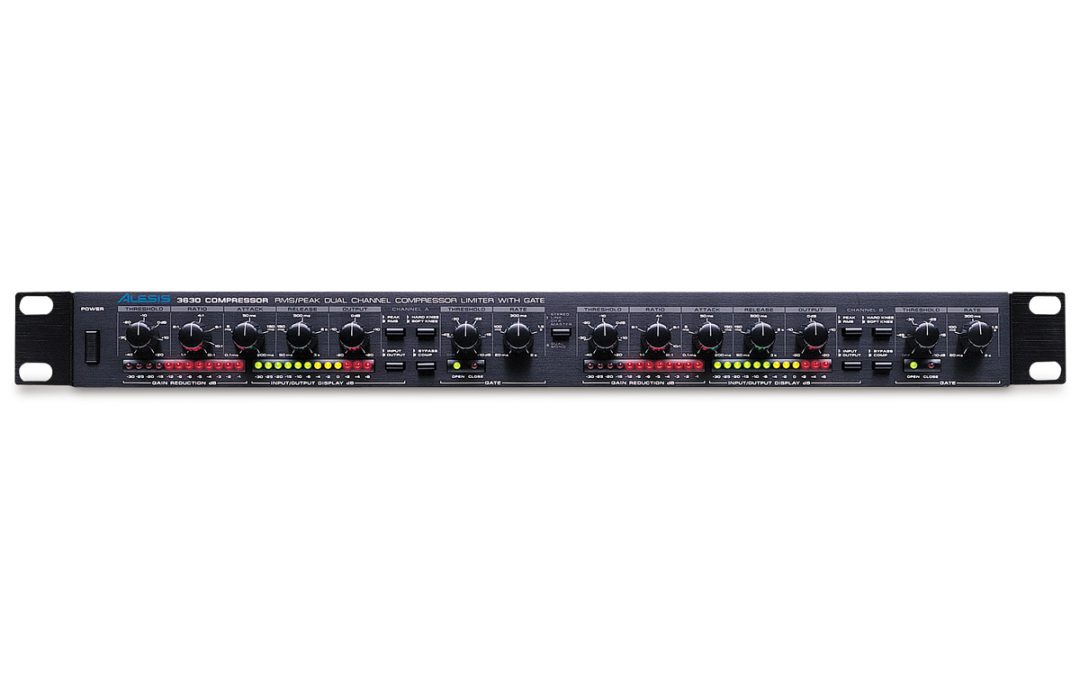The Alesis 3630 compressor is a polarizing piece of equipment. On one hand, it has achieved almost mythic status for its use in the house scene, popularized by groups like Daft Punk. And on the other, it’s just a beginner’s compressor that doesn’t live up to the hype.
Alesis calls it “the most popular dynamics processor ever made.” Obviously that’s a wild statement to anyone who’s ever heard of an 1176, an LA-2A, a Fairchild, a Distressor, a dbx 160, an API 2500—you get the idea. Still, it clearly has a reputation of its own, and truthfully, it’d be unfair to compare it to the likes of the aforementioned.
Alesis 3630 Compressor Review
The Alesis 3630 is a dual-channel compressor with independent controls for each. It can be run in stereo or dual mono, and it’s all housed in a compact 1U rack chassis. The parameters for each channel are more than sufficient; you’ll find settings for ratio, threshold, attack, and decay, as well as a choice between RMS and Peak compression styles. Additionally, each channel has a gate to help control ambient noise.
First impressions are that this is a well designed and manufactured compression unit. Alesis generally makes good stuff, and they didn’t cut any corners with 3630. The price is unbeatable (we’ll get to that), and you get a stereo compressor with a decent amount of features. Unfortunately, that’s where most of the positives end.
In terms of sound, the 3630 takes a ton of work to dial in. People who love this unit will tell you that you can get “Daft Punk sounds” right out of the box, but that really doesn’t seem to be the case. At best, this is a beginner to intermediate compressor because of its affordability.
Realistically, the Alesis 3630 works better as a sound shaping tool than an actual dynamics processor. It adds quite a bit of color to the signal, but not the pleasant kind we associate with higher end stuff. For example, you’d probably never track vocals through a 3630 but you would with an 1176 or LA-2A.
This puts the Alesis 3630 in a weird position. It’s obviously marketed as a quality entry-level dynamics processor; however, it’s difficult to recommend it to someone shopping for their first compressor. Instead, it’s better for producers who want to experiment with sound design and potentially some of the weirder stuff the 3630 can do—not all-around dynamic control.
Price
The Alesis 3630 is discontinued. You can routinely find it for less than $100, with current prices hovering around $60. If you’re on the fence, it’s one of those few pieces that’s actually inexpensive enough to do your own testing.
Features
The following list of features comes courtesy of the Alesis 3630 manual.
- Stereo or dual mono operation. The 3630 can serve as two totally independent units, or both sections can be strapped together for stereo operation. In stereo, gain changes in one section are “tracked” by the other section to eliminate wandering of the stereo image.
- Peak or RMS response. Determines whether the limiter will base its operation on signal peaks or average signal levels. Each has its uses with different types of signals (for example, peak with drums, and average with complex program material).
- “Hard knee” or “soft knee” response. Each type of response gives a different limiting action. The hard knee response is generally considered more “severe,” and the soft knee response, more “musical.”
- Individual bypass switches for each channel. This makes it easy to compare the processed and unprocessed sounds.
- Sidechain connections. Insert EQs and other devices for applications such as de-essing (removing sibilance), adding treble to limited signals, “keying” one signal with another, “ducking” (e.g., making a signal such as background music become lower in volume in response to another signal, such as narration), and other applications.
- +4 dBu or -10dBV operation. This provides signal level compatibility with nearly all studio setups.
- Front panel knob calibrations. Knobs are calibrated to allow for easy setup and operation.
- Built-in stereo/dual mono noise gate. This can reduce noise when compressing or limiting. Each section can also operate as a standalone noise gate.
- Extensive metering. Each channel has a 12-LED display to indicate the amount of gain reduction, a second 12-LED display to show input/ output levels, and a dual-LED display to indicate noise gate status.
How to Use It
I’d recommend it as a heavy-handed sound shaper. You’re not going to lightly compress your vocals or other instruments with this, because it doesn’t do that very well. You can get this thing to pump on the kick, for example, in four-on-the-floor EDM for some extra grit and groove. Or you can just drive the heck out of anything you want to sound “different.” It’s perhaps best as a creative tool for envelope shaping rather than something to control the dynamic range. There are much, much better compressors for that.
